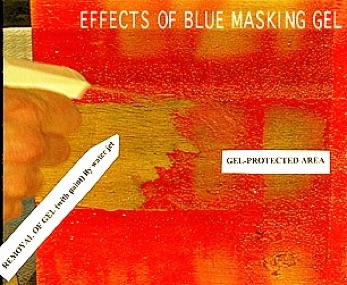This unique 2-part catalyzed carbogel has been designed to temporarily protect clean surfaces from airborne pollutants. It can also be used to mask awkwardly shaped, inaccessible, rough and/or absorbent surfaces against overspray or spills of paint, oil and other contaminants, including airborne dust. The gel (together with contaminants) is removed by use of water jet and/or by use of a brush and a bucket of water.
The application procedure involves daubing the underlying surface with a thin coat of our proprietary surface-activated catalyst. Then the blue gel is applied by sponge, brush or roller. The gel "sets up" to form a gelatinous and impervious "skin". Repeated layers can be built up in order to protect rough and/or porous surfaces (raw wood, non-skid decking, even concrete!). The blue coloration of the gel is non-staining but indicates where it has been applied and how thick the layer is
Under dry conditions, this gelatinous mask can be allowed to remain on the surface for several days when it forms a rubbery skin. This can be thickened by new layers of gel or moistened between sanding coats to help lay dust.
When the job is complete, the gel layer (with overspray etc) is readily removed by water as already described.
Variously shaped clear plastic sheet (similar to overhead transparency material) can be used to produce sharp edged areas of masking by the gel. Also, pieces of this plastic can be slipped into the underside of an automobile molding (on classic cars they are physically fastened) and the gel used to mask both outer and inner surfaces of the molding. Then, the plastic sheet is removed and paint sprayed over the area and behind the molding. Then, when the outer and underside areas of gel are removed, the final result will look as if the molding had been removed for painting, Removal of such moldings is VERY labor intensive and expensive.
We have also used masking gel to protect the new sponge rubber trunk seal of a 1966 Pontiac GTO, while painting the area around the seal. Removing the gel then gave a perfectly detailed area as even areas of adhesive had been painted. Regular masking tape would have torn the delicate trunk seal.
Summarized Advantages over Conventional Masking Techniques:
1. Great savings on time & labor expense of masking.
2. Masks "impossible" surfaces. These include: Raw wood, concrete, cast metal, waxed surfaces, plastics, rubber (see movoe demo on inflatable dinghy) even upholstery and woven fabrics.
3. Masks "impossible areas" . These include:
a) The inside edge of metal moldings so that they do not have to be removed for "restoration" quality paint job (description given above)
b) Lifelines, hoses & small engine parts.
c) Underside of wheel wells and suspension parts.
4. Other advantages:
a) The masking gel lays dust so that masking does not have to be removed and replaced after sanding (sanding dust can ruin a fine paint job).Just apply another coat of masking gel!
b) Use as a flexible "drop cloth" e.g. on the decks or sides of a boat hull while varnishing, painting or doing oil changes.
c) Use in conjustion with fine-edge (blue, from 3M) masking tape. where a sharp painted edge or long straight line is required,
d) Easy removal. Easy clean-up of any gel-masked area with water and brushes. Contrast with some rubber based "liquid masking" that has to be peeled off by hand and is really only suitable for small jobs such as model making.
e) Works in conjunction with members of the ISLAND GIRL® System Most notably IG pInk™ and/or or our Cleanser-Conditioners . They can be used to remove any accidental paint overspray
To Inquire about availability of Hawaiian Blue Masking Gel™ or to special order, call 1-800-441-4425, or contact by text (808 375 0116) or Order Online
